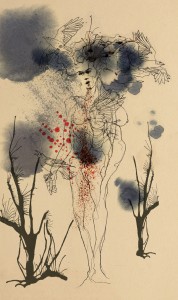
by Christopher Allen
What sets micros apart from longer flash narratives? The word count of course, but the same reduction is used–too simply–to make a difference between the flash narrative and the short story. The micro is variously defined as a narrative under 400, 300 and even 250 words. Competitions, journals, and anthologies have all come up with their own word-count guidelines, and there is of yet no consensus on what microfiction does differently from the slightly heftier and less specific term flash. As we look at five micros from the SmokeLong Quarterly story archive, I hope we will arrive at a clearer understanding of what constitutes a compelling micro narrative.
________________________
Tim Fitts’ “Belly” tells a well-worn tale of voyeurism and childhood sexual curiosity–but let’s take a close look at its layers. First, the story is told somewhere on the POV continuum between a first-person singular and a first-person plural narrator. The quasi-collective voice suits this moment well. In this tight attic space, Fitts develops four characters and even works in a story within the story, which develops the history of Anita and gives the story its title. And the ending is a classic whiplash 180, a move hard to execute in flash without coming off as a punchline. Fitts pulls it off.
Writing Prompt: Write a story about a moment from your childhood, but write it from the collective “we” point of view.
 What we notice first about Rachel Lyon’s “Cannibal” is the narrator’s conversational and contemplative tone as she discusses her loss of appetite–for human flesh. In three taut paragraphs, the narrator serves up intimate and gruesome details of cannibalism. A metaphor of course. I hope. This micro is the type of text that deserves multiple, closer reads. The narrator has lost her appetite since becoming a cannibal herself, while in the last paragraph we learn that she has been consumed by men her whole life. This micro is a challenge to the reader to read sex as consumption, and to consider what happens when the hunger is gone.
What we notice first about Rachel Lyon’s “Cannibal” is the narrator’s conversational and contemplative tone as she discusses her loss of appetite–for human flesh. In three taut paragraphs, the narrator serves up intimate and gruesome details of cannibalism. A metaphor of course. I hope. This micro is the type of text that deserves multiple, closer reads. The narrator has lost her appetite since becoming a cannibal herself, while in the last paragraph we learn that she has been consumed by men her whole life. This micro is a challenge to the reader to read sex as consumption, and to consider what happens when the hunger is gone.
Writing Prompt: Write a micro in three taut paragraphs in which the eaten becomes the eater. Or the killed becomes the killer. Focus on transformation.
 Kerry Cullen’s “Taking Notes,” a finalist in the SmokeLong Quarterly Award for Flash fiction 2018, takes common story fodder and creates something remarkably fresh. This first-person narrative is directed toward the narrator’s bedridden mother. Taking the advice of Doctor Google, the narrator is taking notes while her mother is in hospital as a way of keep her mother safe. “Taking Notes” is also an excellent example of a list story–the notes the narrator is taking.
Kerry Cullen’s “Taking Notes,” a finalist in the SmokeLong Quarterly Award for Flash fiction 2018, takes common story fodder and creates something remarkably fresh. This first-person narrative is directed toward the narrator’s bedridden mother. Taking the advice of Doctor Google, the narrator is taking notes while her mother is in hospital as a way of keep her mother safe. “Taking Notes” is also an excellent example of a list story–the notes the narrator is taking.
 Writing Prompt: Write a list story inspired by Doctor Google.
Writing Prompt: Write a list story inspired by Doctor Google.
In Emily-Jo Hopson’s SmokeLong interview about the story “Zong,” she says, “I tend to see the micro word count offered by flash as a great opportunity to focus on image, symbolism and meaning….” “Zong” is an example of historical fiction, but the micro itself does not explain what “Zong” is (a slave ship) or what is literally happening. The reader does, however, have a sense of the decay and rot of the place.
Writing Prompt: Take a tragic, historic event and write a micro that embodies the shame of it. Choose an object from the event and make it central to your micro.
 William Todd Seabrook’s “Manatees” is another moment told by a group of boys. There is so much left untold in this brief story. It is a confession of sorts. To a murder? Is this a mini-treatise on the survival of the fittest? Are we to understand that the dead manatee is like the weak, afraid child pushed into it? Seabrook’s story resonates long after the splash.
William Todd Seabrook’s “Manatees” is another moment told by a group of boys. There is so much left untold in this brief story. It is a confession of sorts. To a murder? Is this a mini-treatise on the survival of the fittest? Are we to understand that the dead manatee is like the weak, afraid child pushed into it? Seabrook’s story resonates long after the splash.
Writing Prompt: Write a story from the perspective of a character who is culpable, who stands by and does nothing as something ominous happens.
By no means a complete list of micros published by SmokeLong Quarterly:
http://www.smokelong.com/capitalist-brunch/
http://www.smokelong.com/cannibal/
http://www.smokelong.com/zong/
http://www.smokelong.com/belly/
http://www.smokelong.com/the-mystery-of-water/
http://www.smokelong.com/boyandaquarter/
http://www.smokelong.com/the-mess-you-made-in-us/
http://www.smokelong.com/first-night/
http://www.smokelong.com/quake/
http://www.smokelong.com/seven-in-the-morning/
http://www.smokelong.com/chancing/
http://www.smokelong.com/hands/
http://www.smokelong.com/cheering/
http://www.smokelong.com/knowing-love/
http://www.smokelong.com/the-cellist/
http://www.smokelong.com/safe/
http://www.smokelong.com/crossing/
http://www.smokelong.com/postage/
http://www.smokelong.com/instead-of-the-glass/
http://www.smokelong.com/i-m-a-woman-for-sure/
http://www.smokelong.com/they-live-in-black-and-white/
http://www.smokelong.com/moons/
_________________________
 Christopher Allen is the editor-in-chief of SmokeLong Quarterly and the author of the flash fiction collection Other Household Toxins (Matter Press). His work can be found in The Best Small Fictions 2019, Booth, Indiana Review, Split Lip Magazine and others.
Christopher Allen is the editor-in-chief of SmokeLong Quarterly and the author of the flash fiction collection Other Household Toxins (Matter Press). His work can be found in The Best Small Fictions 2019, Booth, Indiana Review, Split Lip Magazine and others.


 The SmokeLong Grand Micro Contest (The Mikey) is now an annual competition celebrating and compensating the best micro fiction and nonfiction online.
The SmokeLong Grand Micro Contest (The Mikey) is now an annual competition celebrating and compensating the best micro fiction and nonfiction online.